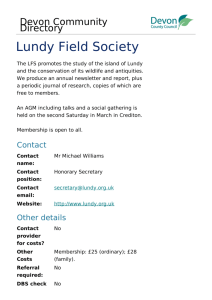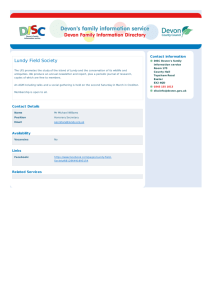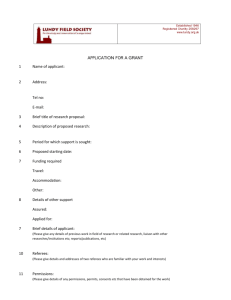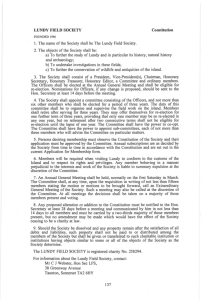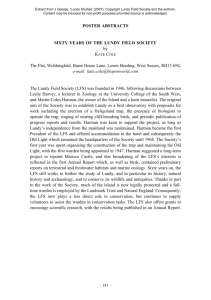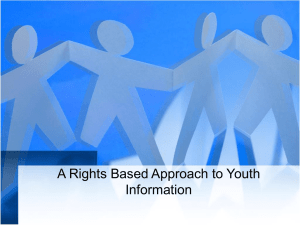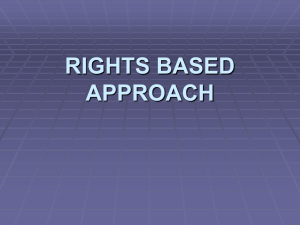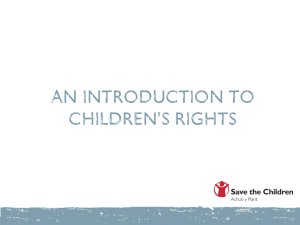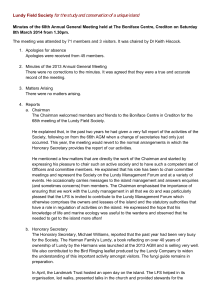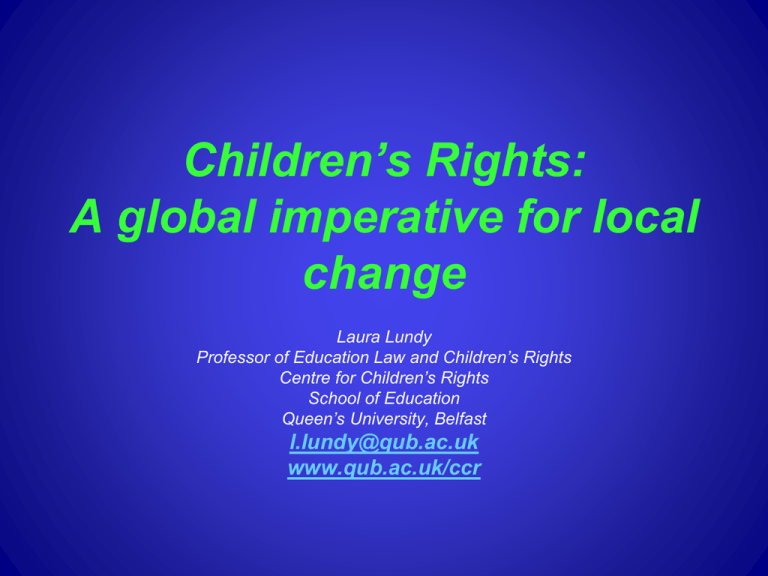
Children’s Rights:
A global imperative for local
change
Laura Lundy
Professor of Education Law and Children’s Rights
Centre for Children’s Rights
School of Education
Queen’s University, Belfast
l.lundy@qub.ac.uk
www.qub.ac.uk/ccr
Outline
• The international human rights of children
• The right of equal access to higher education
• Children’s right to have their views given due weight.
• An example of rights-based participation in practice
• The value of human children’s rights-based approaches in securing
equal access to education.
What are Human Rights?
“The rights one has simply because one is a human being”
Dignity - Equality - Respect
International Human Rights Laws are politically negotiated agreements
by governments to ensure these rights to people in their territory.
Children’s Rights
are Global Human Rights
•
The United Nations Convention on
the Rights of the Child (1989)
•
Most universally ratified of all the UN
Instruments
•
The obligations are legally binding on
the states who ratify them.
•
“..undertake all appropriate
legislative, administrative, and other
measures for the implementation of
the rights”. (Art.4)
Fundamental children’s rights principles
Equality
•
Article 2: States Parties shall respect and ensure the rights set forth in
the present Convention to each child within their jurisdiction without
discrimination of any kind, irrespective of the child's or his or her
parent's or legal guardian's race, colour, sex, language, religion, political or
other opinion, national, ethnic or social origin, property, disability, birth or
other status.
Best interests
•
Art. 3 In all actions concerning children, whether undertaken by public or
private social welfare institutions, courts of law, administrative authorities or
legislative bodies, the best interests of the child shall be a primary
consideration.
Participation
•
Art. 12: States Parties shall assure to the child who is capable of forming
his or her own views the right to express those views freely in all matters
affecting the child, the views of the child being given due weight in
accordance with the age and maturity of the child.
Right of Equal Access
to
Higher Education
The Right to Education
(Art. 28, UNCRC)
States Parties recognize the right of the child to education, and with a view to
achieving this right progressively and on the basis of equal opportunity, they
shall, in particular:
(a) Make primary education compulsory and available free to all;
(b) Encourage the development of different forms of secondary education,
including general and vocational education, make them available and
accessible to every child, and take appropriate measures such as the
introduction of free education and offering financial assistance in case of need;
(c) Make higher education accessible to all on the basis of
capacity by every appropriate means;
(d) Make educational and vocational information and guidance available and
accessible to all children;
(e) Take measures to encourage regular attendance at schools and the
reduction of drop-out rates.
The aims of education
(Art. 29 UNCRC)
States Parties agree that the education of the child shall be directed to:
• (a) The development of the child's personality, talents and mental and
physical abilities to their fullest potential;
• (b) The development of respect for human rights and fundamental
freedoms, and for the principles enshrined in the Charter of the United
Nations;
• (c) The development of respect for the child's parents, his or her own
cultural identity, language and values, for the national values of the
country in which the child is living, the country from which he or she
may originate, and for civilizations different from his or her own;
• (d) The preparation of the child for responsible life in a free society, in the
spirit of understanding, peace, tolerance, equality of sexes, and friendship
among all peoples, ethnic, national and religious groups and persons of
indigenous origin;
•
(e) The development of respect for the natural environment
.
The Right to Education:
Tomasevski’s 4 A framework
“Most children enter primary school but a fraction
reaches the university. Pre-requisites for moving
upwards are apparently objective and justified,
and are rarely challenged as a violation of the
right to education. And yet, the very design of
education denies an equal opportunity to reach
the pinnacle to the majority of those who start
school. Failures are necessary because each
step upwards, the education pyramid
accommodates fewer people”
Tomasevski, 2006, p.103
The right to participate
“States Parties shall assure to the child who
is capable of forming his or her own views
the right to express those views freely in
all matters affecting the child, the views of
the child being given due weight in
accordance with the age and maturity of
the child.”
Article 12 of the UNCRC
The significance of Article 12
• One of the most innovative (and
controversial) provisions in the CRC.
• “recognises the child as a full human
being with integrity and personality
and the ability to participate freely in
society.” (Freeman, 2000).
• Not just a right in itself but also a
means of realising other rights and
so a barometer for children’s rights
more generally.
“A boy not getting a say in a
conversation”
Article what?
The Voice of the Child
The Right to be Heard
The Right to Participate
The Right to be Consulted
The Right to Have a Say
Each of these abbreviations is an imperfect summary of
Article 12 and can potentially undermine its
implementation
(Lundy, 2007)
VOICE
SPACE
Safe and inclusive
opportunity to
form and express
a view
The right
to express
views
Facilitated to
express views
freely in medium of
choice
ARTICLE 12
AUDIENCE
The view must be
listened to
The right to
have views
given due
INFLUENCE
weight
The view must be
acted upon
An example of children’s
rights-based participation
• Research for The Wellcome
Trust on children’s attitudes to
science assessment in
primary schools in England
and Wales
(C. Murphy, L. Lundy, K.
• Worked with Children’s
Research Advisory Groups
(CRAGS) in each country to
design questionnaires and
interpret the results.
Kerr and L. McEvoy,
Attitudes of Children and
Parents to Key Stage 2
Science Assessment and
Testing, 2010)
What is the best way to
assess primary school
science?
Assisting children to
(in)formed views
(Lundy and McEvoy, 2012)
Helping children to reach
“a clarified decision”
Providing space to express
views freely
Facilitating children’s views
90% of participants indicated that they found it
either useful or very useful to have other children’s
views
• ‘It was quite interesting to hear about how other people
think about science because you can decide if you have
same opinions or not’
•
‘It was giving you confidence to say how you feel about
science’
Encouraging fuller responses
Participant responses in ‘free response’ boxes were noticeably more
extensive and detailed: participants wrote an average of 15 words in
their responses compared to an average of 6.4 words when other
children’s views not provided.
• ‘i would assess science by doing a project and getting marks on that and
maybe have a small test after. The project could be like a revision thing but
better and funner’.
•
‘I would let the children bring their own experiments into the classroom and
explain how to do them. I would encourage them to research new ideas to
make it enjoyable and interesting’
•
‘I would ask the class how they would like to do it’
Why adopt a children’s
rights-based approach?
The value of a children’s
rights framing
• Global and legal legitimacy
• International fora for action… “the mobilisation of
shame”.
• Emphasis on state accountability.
• Requirement to engage with children and young people
as rights-holders and agents of change.
• Participation is “the right of the child and not the gift of
adults.
A language of and for action
Rights are not mere gifts or favors…for which
gratitude is the sole fitting response. A right is
something that can be demanded or insisted
upon without embarrassment or shame. …A
world with claim rights is one in which all
persons are dignified objects of respect.”
(Joel Feinberg)

